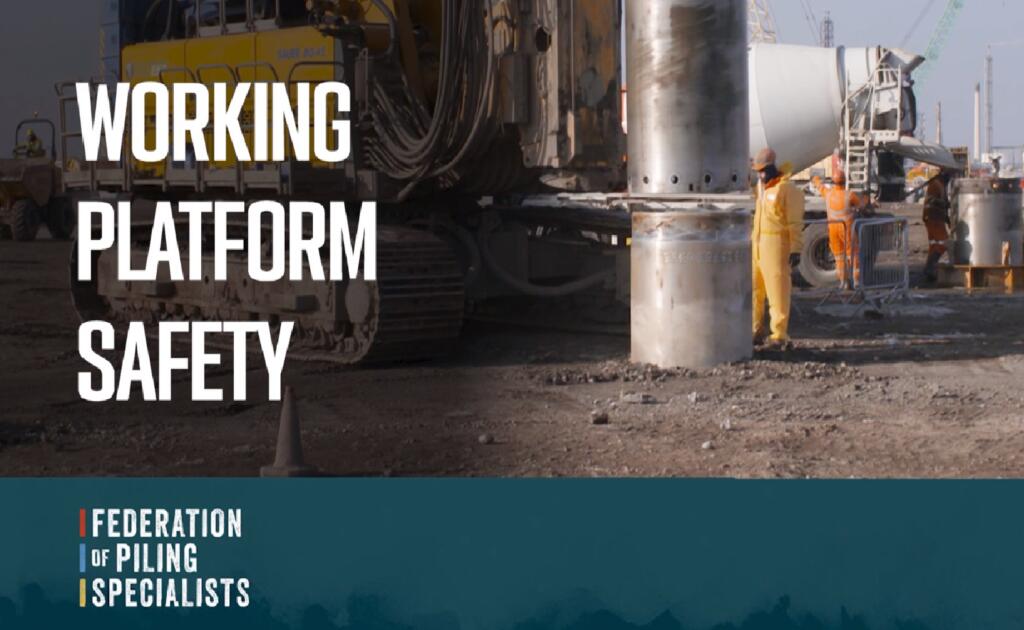
With safety always a priority of the FPS, and in particular, working platform safety, the Federation of Piling Specialists (FPS) Chair John Chick jumped at the chance to participate in Ground Engineering magazine’s recent round table discussion about Working Platform Safety.
The discussion was organised to examine what more can be done to reduce risk and promote safety following a number of recent incidents of rigs overturning, attributed to failures of the working platform.
The discussion started with a reminder of the 2003 incident when a 25m tall piling rig overturned on a Channel Tunnel Rail Link construction site, across a live running line along which a passenger train had passed shortly before. The Health & Safety Executive (HSE) concluded that the main contractor had failed to reinstate the platform adequately after digging a trench to remove an obstruction.
How this incident established BR 470 ‘Working platforms for tracked plant’ guidance, was covered and how it helped establish the working platform certificate as the standard. Its shortcomings were also highlighted in the discussion as well as the question of how the industry can get more people to use it. John Chick worryingly spoke of hearing at least two members say they had been told not to follow it by principal contractors.
Other concerns, such as quality of the material being used, platform thicknesses, and getting platforms designed and signed off by clients were raised. One participant in the discussion felt the piling mat has become an area clients want to cut back on.
The work the European Federation of Foundation Contractors (EFFC) and Deep Foundations Institute (DFI) are doing to update their “Guide to Working Platforms”, which was originally released in 2020, was highlighted and how they are looking to compare different testing methods for working platforms that can ensure they are fit for purpose, as well as being quick and low cost.
John also spoke of the attitudinal change that has occurred in recent years, as well as a loss of awareness of what can go wrong if the platform is not adequate. He commented “And it’s only going to get worse, because there’s a bit of an arms race in plant with rigs getting bigger, masts getting taller – particularly in the CFA (Continuous Flight Auger) market. You’re now looking at rigs that are 36-37m tall – if that goes over, it’s going to land two streets away”.
The forum addressed the lack of good quality fill material for the creation of the working platforms. The consensus was, the nature of delivered materials, often with too many fines and random debris, renders 6F5 as not being fit for purpose.
The impact of sustainability on platform design was discussed and how it is generating ill-thought through complaints that piling platforms are over designed and conservative, without actually recognising that safe platform design must never be compromised to meet sustainability goals. Discussions also covered the importance of testing a designed platform once it has been built and not to rely on simply building to specification and may even benefit from independent assessment.
The round table discussion highlighted just how many factors must be tackled to ensure greater safety and working platform integrity, but emphasised the will to see change, with many parties working towards reducing risk.
Although the FPS has done much to promote working platform safety through guidance and initiatives the Federation recognises how critical an issue it is on site. In fact, it has launched a safety video on the topic, which can be found here: https://www.fps.org.uk/news-views/press-release/working-platform-safety-video-launched-by-fps/
A more in-depth precis of the discussions can be found in the August/September 2023 issue of Ground Engineering magazine (P.24, 25, 26).
Available guidance can be found:
- The CIRIA “SP123 Soil reinforcement with geosynthetics” document from 1996 explains the principles of reinforced soil behaviour and provides guidance on design and analysis.
- BRE published the “BR 470 Working platforms for tracked plant: good practice guide to the design, installation, maintenance and repair of ground-supported working platforms guidance” in 2004 on behalf of the Federation of Piling Specialist (FPS). The FPS also made it mandatory for its members to adopt working platform certification in 2004. A new version of the BR 470, with a revised approach to stabilisation design with multiaxial hexagonal geogrids, was published in 2019.
- Temporary Works Forum published the “Working Platforms – Design of granular working platforms for construction plant: A guide to good practice” in 2019, which further clarifies the earlier design approaches of Ciria SP123 (1996) and BRE 470 (2004).
- The joint Working Platforms Task Group of the European Federation of Foundation Contractors (EFFC) and Deep Foundations Institute (DFI) released its “Guide to Working Platforms” in 2020.
- The Steel Piling Group shared a guidance note and developer guide on “Working platform requirements for tracked excavator piling rigs” in January 2023.